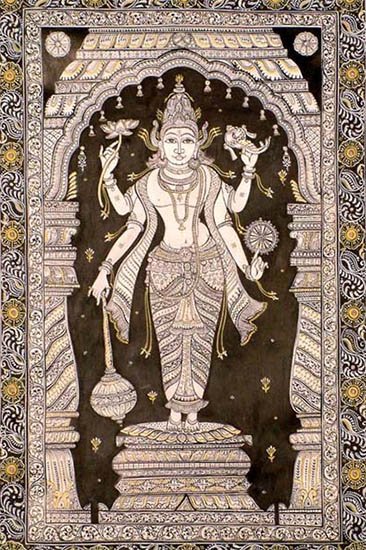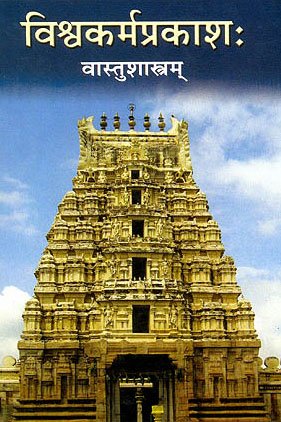Kudya, Kuḍya, Kūḍya: 18 definitions
Introduction:
Kudya means something in Buddhism, Pali, Hinduism, Sanskrit, the history of ancient India, Marathi. If you want to know the exact meaning, history, etymology or English translation of this term then check out the descriptions on this page. Add your comment or reference to a book if you want to contribute to this summary article.
In Hinduism
Shilpashastra (iconography)
Source: Wisdom Library: Śilpa-śāstraKuḍya (कुड्य) refers to the “walls” of a temple. It is also known as bhitti.
There are four commonly used classifications of kuḍyas:
- jālakakuḍya (perforated wall),
- iṣṭakakuḍya (brick wall),
- phalakakuḍya (wood or stone wall).
- mṛnmayakuḍya (clay wall)
Kuḍya (कुड्य) refers to the “plastered wall” which was used as a Canvas in the ancient Indian art of Painting (citra), according to the Viṣṇudharmottarapurāṇa, an ancient Sanskrit text which (being encyclopedic in nature) deals with a variety of cultural topics such as arts, architecture, music, grammar and astronomy.—Canvas is a kind of surface on which a painter can draw a picture. In ancient time walls are seen to be plastered with different substances and these were prepared for Painting. The plastered wall which was used as canvas is known as kuḍya or bhitti. The process of preparing those walls for Painting was called as kuḍyanirmāṇa or bhittinirmāṇa. In the Viṣṇudharmottarapurāṇa, it is suggested that before going to start Painting on walls one should plaster a wall. For the process of kuḍya i.e., plastering on a wall, the painter needs iṣṭakācūrṇa i.e., powder of bricks and mṛd i.e., clay as basic ingredients. To prepare this at first the powder of three kinds of brick and one third of clay should be mixed.

Shilpashastra (शिल्पशास्त्र, śilpaśāstra) represents the ancient Indian science (shastra) of creative arts (shilpa) such as sculpture, iconography and painting. Closely related to Vastushastra (architecture), they often share the same literature.
Vastushastra (architecture)
Source: OpenEdition books: Architectural terms contained in Ajitāgama and RauravāgamaKuḍya (कुड्य) refers to “wall §§ 3.16; 4.17; 5.5.”.—(For paragraphs cf. Les enseignements architecturaux de l'Ajitāgama et du Rauravāgama by Bruno Dagens)

Vastushastra (वास्तुशास्त्र, vāstuśāstra) refers to the ancient Indian science (shastra) of architecture (vastu), dealing with topics such architecture, sculpture, town-building, fort building and various other constructions. Vastu also deals with the philosophy of the architectural relation with the cosmic universe.
Shaivism (Shaiva philosophy)
Source: Brill: Śaivism and the Tantric Traditions (philosophy)Kuḍya (कुड्य) refers to the “walls (of a house)”, according to the Vṛtti on the Īśvarapratyabhijñāvivṛtivimarśinī 2.165.—Accordingly, “In ‘To this [objection we] reply …,’ [Utpaladeva] answers [the objection] with [the following] in mind. The externality of the pot is not thus one [and the same whether it is considered] with respect to the village or with respect to consciousness; for that which is external to consciousness consists in that which is not consciousness, whereas that which is external to the house does not consist in that which is not a house! For if that were the case, a particular element of the house—such as a wall (kuḍya)—or a pot, for example, although it is located inside the house, should be external to the house [since they are not the house itself]; and it is not so.

Shaiva (शैव, śaiva) or Shaivism (śaivism) represents a tradition of Hinduism worshiping Shiva as the supreme being. Closely related to Shaktism, Shaiva literature includes a range of scriptures, including Tantras, while the root of this tradition may be traced back to the ancient Vedas.
In Buddhism
Mahayana (major branch of Buddhism)
Source: academia.edu: A Study and Translation of the GaganagañjaparipṛcchāKuḍya (कुड्य) refers to “walls”, according to the Gaganagañjaparipṛcchā: the eighth chapter of the Mahāsaṃnipāta (a collection of Mahāyāna Buddhist Sūtras).—Accordingly, “[...] There is no self, being, life-principle, life-sustaining principle, spirit, personality, human being, or man; in the dharmas which are dependently originated there is no true origination and there is no owner. Therefore, all dharmas are like (sadṛśa) grass (tṛṇa), trees (kāṣṭha), walls (kuḍya), paths (mārga), and reflections (pratibhāsa). [...]”.

Mahayana (महायान, mahāyāna) is a major branch of Buddhism focusing on the path of a Bodhisattva (spiritual aspirants/ enlightened beings). Extant literature is vast and primarely composed in the Sanskrit language. There are many sūtras of which some of the earliest are the various Prajñāpāramitā sūtras.
India history and geography
Source: Cologne Digital Sanskrit Dictionaries: Indian Epigraphical GlossaryKuḍya.—probably, ‘a mound’; see eḍuka. Note: kuḍya is defined in the “Indian epigraphical glossary” as it can be found on ancient inscriptions commonly written in Sanskrit, Prakrit or Dravidian languages.

The history of India traces the identification of countries, villages, towns and other regions of India, as well as mythology, zoology, royal dynasties, rulers, tribes, local festivities and traditions and regional languages. Ancient India enjoyed religious freedom and encourages the path of Dharma, a concept common to Buddhism, Hinduism, and Jainism.
Languages of India and abroad
Marathi-English dictionary
Source: DDSA: The Molesworth Marathi and English Dictionarykuḍyā (कुड्या) [or कुढ्या, kuḍhyā].—a (kuḍaṇēṃ or kuḍhaṇēṃ) Given to sulking or fretting.
Marathi is an Indo-European language having over 70 million native speakers people in (predominantly) Maharashtra India. Marathi, like many other Indo-Aryan languages, evolved from early forms of Prakrit, which itself is a subset of Sanskrit, one of the most ancient languages of the world.
Sanskrit dictionary
Source: DDSA: The practical Sanskrit-English dictionaryKuḍya (कुड्य).—
1) A wall; भेदे कुड्यावपातने (bhede kuḍyāvapātane) Y.2.223; Śiśupālavadha 3.45 विनमितपटलान्तं दृश्यते जीर्णकुड्यम् (vinamitapaṭalāntaṃ dṛśyate jīrṇakuḍyam) Mu.3.15.
2) Plastering (a wall).
3) Eagerness, curiosity.
-ḍyā A wall; कीटः पेशस्कृतारूद्धः कुड्यायां तमनुस्मरन् (kīṭaḥ peśaskṛtārūddhaḥ kuḍyāyāṃ tamanusmaran) Bhāgavata 7.1.28.
Derivable forms: kuḍyam (कुड्यम्).
--- OR ---
Kūḍya (कूड्य).—= कुष्य (kuṣya) q. v.
Derivable forms: kūḍyam (कूड्यम्).
Source: Cologne Digital Sanskrit Dictionaries: Edgerton Buddhist Hybrid Sanskrit DictionaryKuḍyā (कुड्या).—(or kuḍya, m.? in Sanskrit nt., except f. Gr. and once BhāgP., see [Boehtlingk and Roth]; according to [Paia-sadda-mahaṇṇavo] m. or nt. in Prakrit), wall: Saddharmapuṇḍarīka 83.5 (verse) kuḍyāś (WT em. °yā) ca bhittīś ca (influence of the gender of bhitti?); n. pl.
Source: Cologne Digital Sanskrit Dictionaries: Shabda-Sagara Sanskrit-English DictionaryKuḍya (कुड्य).—n.
(-ḍyaṃ) 1. A wall. 2. Anointing, plastering. 3. Eagerness, curiosity. E. ku to sound, and ḍyan affix, or kuḍ to heap, &c. and kyap affix; also kūḍya.
--- OR ---
Kudya (कुद्य).—n.
(-dyaṃ) A wall: see kuḍya.
--- OR ---
Kūḍya (कूड्य).—n.
(-ḍyaṃ) A wall: see kuḍya.
Source: Cologne Digital Sanskrit Dictionaries: Benfey Sanskrit-English DictionaryKuḍya (कुड्य).—n. A wall, [Yājñavalkya, (ed. Stenzler.)] 2, 223.
Source: Cologne Digital Sanskrit Dictionaries: Cappeller Sanskrit-English DictionaryKuḍya (कुड्य).—[neuter] ā [feminine] wall.
Source: Cologne Digital Sanskrit Dictionaries: Monier-Williams Sanskrit-English Dictionary1) Kuḍya (कुड्य):—n. a wall, [Yājñavalkya; Mahābhārata] etc.
2) plastering (a wall), [cf. Lexicographers, esp. such as amarasiṃha, halāyudha, hemacandra, etc.]
3) curiosity, [cf. Lexicographers, esp. such as amarasiṃha, halāyudha, hemacandra, etc.]
4) Kuḍyā (कुड्या):—[from kuḍya] f. ([gana] kattry-ādi) a wall, [Bhāgavata-purāṇa vii, 1, 27.]
5) Kudya (कुद्य):—for kuḍya q.v.
6) Kūḍya (कूड्य):—n. (= kuḍya) a wall, [cf. Lexicographers, esp. such as amarasiṃha, halāyudha, hemacandra, etc.]
Source: Cologne Digital Sanskrit Dictionaries: Yates Sanskrit-English Dictionary1) Kuḍya (कुड्य):—(ḍyaṃ) 1. n. A wall; anointing, plastering; eagerness, curiosity.
2) Kudya (कुद्य):—(dyaṃ) 1. n. A wall.
3) Kūḍya (कूड्य):—(ḍyaṃ) 1. n. A wall.
Source: DDSA: Paia-sadda-mahannavo; a comprehensive Prakrit Hindi dictionary (S)Kuḍya (कुड्य) in the Sanskrit language is related to the Prakrit words: Kuḍḍa, Kuliya.
[Sanskrit to German]
Sanskrit, also spelled संस्कृतम् (saṃskṛtam), is an ancient language of India commonly seen as the grandmother of the Indo-European language family (even English!). Closely allied with Prakrit and Pali, Sanskrit is more exhaustive in both grammar and terms and has the most extensive collection of literature in the world, greatly surpassing its sister-languages Greek and Latin.
Kannada-English dictionary
Source: Alar: Kannada-English corpusKuḍya (ಕುಡ್ಯ):—[noun] a continuous and vertical structure usu. of brick or stone, having little width in proportion to its length and height and esp. enclosing, protecting or dividing a space or supporting a roof; a wall.
Kannada is a Dravidian language (as opposed to the Indo-European language family) mainly spoken in the southwestern region of India.
See also (Relevant definitions)
Starts with: Kudyacchedin, Kudyacchedya, Kudyachchhedin, Kudyachchhedya, Kudyaka, Kudyakeshi, Kudyalepa, Kudyamatsi, Kudyamatsya, Kudyamula, Kudyanirmana, Kudyapuccha, Kudyatha.
Ends with: Hemakudya, Ishtakakudya, Jalakakudya, Kapatakudya, Mrinmayakudya, Phalakakudya, Sphatikakudya, Tirahkudya, Tiraskudya.
Full-text (+51): Kaudeyaka, Kuliya, Kudyacchedin, Kudyacchedya, Kudyamatsya, Kudyamatsi, Kudda, Kudyaka, Sphatikakudya, Tirahkudya, Kudde, Bhitti, Parikuddaleti, Kudyapuccha, Kudyalepa, Nikud, Hemakutya, Sphatikabhitti, Hemakudya, Chedya.
Relevant text
Search found 11 books and stories containing Kudya, Kuḍya, Kuḍyā, Kūḍya; (plurals include: Kudyas, Kuḍyas, Kuḍyās, Kūḍyas). You can also click to the full overview containing English textual excerpts. Below are direct links for the most relevant articles:
Vishnudharmottara Purana (Art and Architecture) (by Bhagyashree Sarma)
5. Preparation of Canvas before Painting < [Chapter 5 - Painting and Image Making]
Samarangana-sutradhara (Summary) (by D. N. Shukla)
Garga Samhita (English) (by Danavir Goswami)
Verse 1.2.38 < [Chapter 2 - Description of the Abode of Śrī Goloka]
Kashyapa Shilpa-shastra (study) (by K. Vidyuta)
4. Fourteen types of Samāśra (Square) Maṇḍapas < [Chapter 4 - Maṇḍapa Lakṣaṇa]
4. Prākāra components (2): Pāda-māna < [Chapter 3 - Prākāra Lakṣaṇa]
8. Śālā, Sabhā and Mālikā-kāra Lakṣaṇas < [Chapter 5 - Gopura Lakṣaṇa]
Manasara (English translation) (by Prasanna Kumar Acharya)
Chapter 31 - The Courts (prākāra)
Chapter 35 - The storeyed mansions (śālā)
Chapter 36 - The situation and measurement of dwelling houses (gṛha-māna-sthāna)
The Agni Purana (by N. Gangadharan)